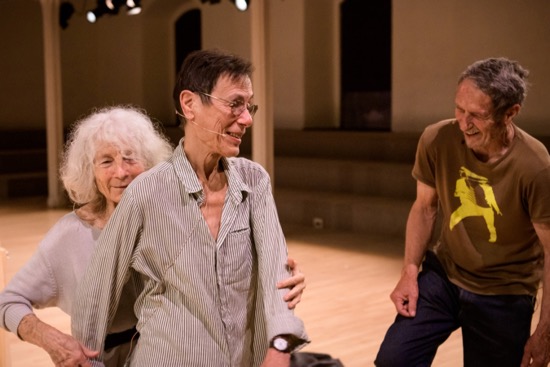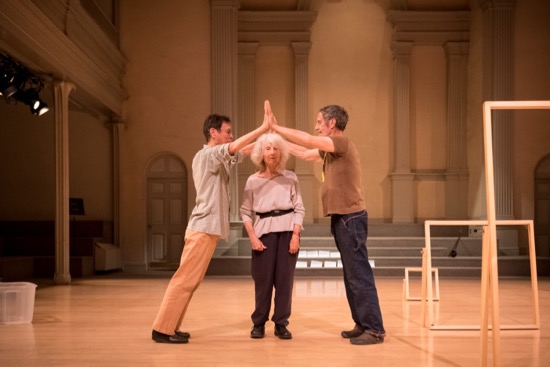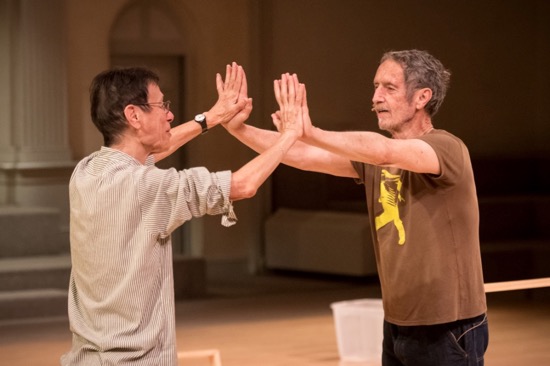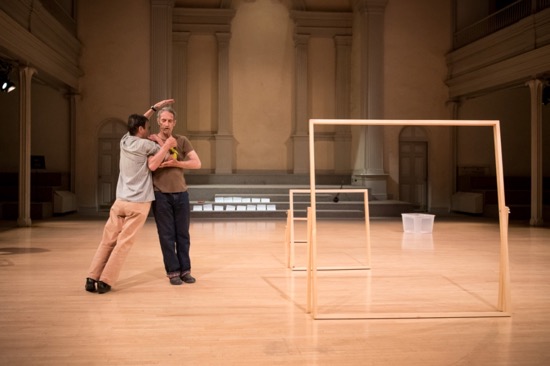Simone Forti, Steve Paxton, and Yvonne Rainer get together at Saint Mark’s Church.

(L to R): Simone Forti, Yvonne Rainer, and Steve Paxton rehearsing. Photo: Ian Douglas
“It is better to have loved and lost than to have put linoleum on your living room floor.” Yvonne Rainer read that aloud during her 2016 The Concept of Dust: Continuous Project— Altered Annually. And she read it again from one of the sheets of paper taped to the pillars in Saint Mark’s Church during Danspace Project’s presentation of Tea for Three: Simone Forti, Steve Paxton, Yvonne Rainer. Searching for the source of the quote, I’m immediately lost in online ads for linoleum that you might really want to put on your floor. That’s life today.
On this historic occasion, three friends and colleagues who have never before performed as a trio, are improvising together. Steve Paxton lives in Vermont; Yvonne Rainer lives in New York; Simone Forti, who once lived in New York and in Vermont near Paxton, lives in Los Angeles. Forti and Rainer must have met in Anna Halprin’s workshops on her outdoor deck on Mount Tamalpais in Northern California during the late 1950s. All three took part in Robert Dunn’s iconoclastic composition classes of the 1960s and showed their work in Judson Church. Paxton and, for a while Rainer, were members of the epic improv group, The Grand Union. Once upon a time, you could find Forti, Paxton, Trisha Brown, David Gordon, and Douglas Dunn (all but Forti Grand Unioneers) living and showing their work in lofts within a block or two of one another.
The church is crammed, and a surprising number of spectators are young. One group of college-age kids lassoed my friend to take a group picture of them outside the church. They’ve probably read about these artists in history classes or experienced sessions of Paxton’s invention: Contact Improvisation. Maybe some of them have taken, or will take, one of Forti’s “Body Mind World” workshops in Saint Mark’s. Her written description of it: “By letting our body intelligence and our verbal mind interact, we will access a fuller view of our world, both personal and collective.” That’s sort of what the performance stimulates too.
As you may have guessed, Forti, Paxton, and Rainer are not young (nor am I). That they are formidably smart and serious about art-making is a given, and, as those familiar with their work know, they are also intrepid, witty, and playful. An enlivening combination.

Tea for Three. (L to R): Yvonne Rainer, Simone Forti, and Steve Paxton. Photo: Ian Douglas
They are fiddling around as the spectators enter, talking in low voices, trying things out (such as knotting their arms together). Paxton paces the perimeter, moving his arms fluidly, as if conducting a pleasant tune. Above them, projected on the wall above the altar platform, is a film (“A Free Consultation”). Jason Underhill’s camera has accompanied Forti on an arduous voyage. In her work, she has been involved with sensing the earth and the animals that inhabit it—getting inside these, feeling one with them in some way. So here she is in a snowy landscape, bundled up and on her belly, crawling and scrabbling over rough terrain. Once she has to clamber over a big chunk of driftwood. Is it the sea in the distance that she’s heading for? She has a portable windup radio whose aerial she aims in various directions. I wonder if she’s finding what it’s like to be a turtle looking for the place to lay her eggs.
One of the things I like about watching terrifically sophisticated performers improvise is the way they pay attention to one another—ready to help, fall in line with, or surprise someone. A few elements are probably planned. Probably Carol Mullins’ lighting. There’s a long red scarf that Forti feels, which leads to Rainer remembering how often Forti used to reach out and rub the fabric of, say, her friend’s sleeve between her fingers. That same scarf becomes Paxton’s bulky necktie for a while, and later Forti drapes it over Rainer’s head. Once it turns into a lash for Forti to wield and perhaps intimidate (?) her colleagues. The tie that binds? You can also see/hear Forti’s sensitivity to texture, when she lies on the floor rolling around with a big piece of black material that makes crunching noises as a result of her exertions. Another prop is hers alone; it’s called an Earth Horn and attributed in the program to Yoshi Wada. She blows into one end of a long metal tube attached to an indescribable, semi-globular metal object and we hear deep, melodic tones.
Without losing their equanimity or their patience, the three attempt difficult tasks. A film excerpt from Rainer’s 2012 Assisted Living: Good Sports 2 shows a group performing her famous Trio A of the 1960s, each in his/her own time. After some discussion, Rainer tries to execute its long string of non-repeating moves. But this time, Forti is butted up against her from behind, holding onto her and trying to follow the steps. I don’t need to tell you how hard this is. Paxton follows, ready to help if necessary.

Rainer and Paxton face off. Photo: Ian Douglas
Another proposition on this particular night involves doing a pushup and then considering taking both feet and hands off the floor for a second. That plan is abandoned. However, Forti, solves the problem in another way. She goes to a chair and, belly-down, maintains herself in a plank position across its seat. This is so impressive that Rainer and Paxton decide to move the chair to the center of the space with her on it. Too heavy! The situation is resolved when they recruit audience members to help lift the chair, now (I forget why) with Rainer braced across it.
At home later, leafing through Forti’s Handbook in Motion: An Account of an Ongoing Personal Discourse and Its Manifestations in Dance (1974 and republished twice since), I come across this performance task: “One person shakes a pan of nails very loudly, while another sings a song very loudly. The volume should be in perfect balance.”
The balance between these three comrades skews and skedaddles this way and that. Rainer is nimble and shows herself to be a good-humored, take-charge person, amused by what’s developing. Forti is the smallest of the three. Following Rainer as she gallops around, this formidably intelligent woman suddenly looks like an adventurous child. When her hands tremble involuntarily, we can believe that she’s holding butterflies. Paxton is more aloof, calm, a man of few words, but one always ready to catch a colleague if she risks falling. After Rainer has read a line that goes something like “women not invited to the table are on the menu,” she and Forti, their arms around each other in a girlfriendly manner, confront him. Rainer asks him what runs in his family; he ponders, then says, “Arizona sarcasm is tougher than cactus.” His folks “sarc-ed” at one another a lot.
Being in the church is like being at an eccentric feast. Most of the fare is adventurous, delicious; some it is indecipherable (raisins inside it, or. . . ?). The row of empty wooden frames, ranging in size from walk-through size to tiny, are rearranged—no longer is the smallest nearest to us, but the largest. A comment about present and past perspectives, or just something to crawl through? On the other hand, although I’m baffled by a game that Paxton and Rainer play, I don’t question its credibility or wonder at its significance. I think it’s called “arm drop.” They face each other, forearms on top of forearms, but this is not about slapping hands. Their moves—lift, circle, drop— assume the air of a graceful conversation; the two can accompany these with verbal communication the way a good knitter can talk to you without dropping a stitch.

Leaning together. Yvonne Rainer (R) and Steve Paxton rehearsing in the empty church. Photo: Ian Gibson
The passage of time—dreaded or hoped-for—hovers as a subject. Paxton, reading from one of the pieces of paper, marvels at the news that the fossil of a creature resembling a hedgehog (we see a projected reconstruction) has been dated to 52 million years ago. Does this connect to Forti patting Rainer’s crouched-down back and saying “what soft fur. . . ”?
Perhaps inevitably, the specter of Donald Trump emerges, spawned by Rainer’s attempt to jolt Paxton out of his amiability and into anger. When the three of them cluster again and tangle their arms together, Rainer is wearing a paper Trump mask. This is not a reference to Halloween. Or, well, it could be. Too. There’s more about fascism; Mussolini is mentioned, but not, I think, by name.
Rainer checks her watch once or twice. At a certain point, she decides it’s time to end the hour-long piece. The others aren’t so sure. Nor is she, really. But she does exit, and the two stare after her as the lights go out. Tea for Three? Nothing so staid or refined or diluted. Imagination, brain power, social awareness, and bravery downed neat.

Beautiful piece. I especially love the image of Simone holding butterflies in her trembling Parkinson’s hand. And thank you for calling the Grand Union “epic.” I certainly agree, even though it lasted only six years.
Yvonne and Simone actually met through Nancy Meehan. It’s on page 190 of Yvonne’s autobiography, “Feelings Are Facts.” All three were taking the June course at the Graham school and later rented a studio to improvise together. It was Simone who convinced Yvonne to come to the Halprin workshop in August 1960. And the next month, they both met Steve at Robert Dunn’s workshop in the Cunningham studio. And the sparks began to fly.
Thanks so much, Wendy, for clarifying the history of how these three connected. I had forgotten that Nancy Meehan was involved, and I never knew that all three took Graham’s June course.